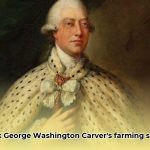Ever heard of George Washington Carver? Most people know him for peanuts, but the truth is, he revolutionized farming. He showed farmers how to keep the soil healthy and make the most of what they planted. This story is about how his brilliant ideas can still help us build a better, more sustainable food system today. We’ll explore his life, farming tricks, and how we can use his wisdom to create a healthier planet.
George Washington Carver: The Innovator Who Revolutionized Agriculture
A Life Forged in the Fields: Understanding Agricultural Innovation
Born into slavery near Diamond Grove, Missouri, around 1864, George Washington Carver’s early life profoundly shaped his understanding of the natural world. His dedication to education led him to Iowa State Agricultural College (now Iowa State University), where he earned both a bachelor’s and a master’s degree in agricultural science. In 1896, he joined the Tuskegee Institute in Alabama, dedicating his career to helping Southern farmers improve their land and livelihoods, which marked a pivotal moment in agricultural history.
Carver’s Vision: Sustainable Farming for Everyone – Promoting Crop Diversity
Carver’s genius wasn’t about inventing a miracle crop; it was about a complete transformation of farming practices. He understood that the South’s reliance on cotton had depleted the soil, leaving farmers vulnerable to poverty. His work emphasized sustainability and resilience, principles that are increasingly relevant in the face of climate change and food security challenges.
Rotating Crops: A Soil’s Best Friend – Natural Soil Nutrients
Carver championed crop rotation as a cornerstone of sustainable farming. By alternating crops, farmers could replenish nutrients in the soil naturally. He advocated for planting legumes like peanuts and soybeans, which fix nitrogen in the soil, enriching it for subsequent crops. This practice reduced the need for synthetic fertilizers, improved soil health, and increased yields.
Soil’s Secret Weapon: Natural Fertilizers and Soil Health
Carver’s resourcefulness extended to the use of natural fertilizers. He encouraged farmers to utilize readily available materials like swamp muck, compost, and animal manure to enrich the soil. These organic amendments provided essential nutrients and improved soil structure, water retention, and overall fertility. By harnessing local resources, farmers could reduce their reliance on costly commercial fertilizers and create healthier, more resilient ecosystems.
Beyond Peanuts: A Rainbow of Crops and Uses – Crop Diversification
While Carver is best known for his work with peanuts, his impact extended far beyond this single crop. He also explored the potential of sweet potatoes, soybeans, pecans, and other plants. He developed hundreds of uses for these crops, ranging from food products like flour, milk, and oil to industrial applications like dyes, plastics, and adhesives. This crop diversification not only improved soil health but also created new economic opportunities for farmers, promoting diversification.
Sharing Knowledge: Empowering Farmers Through Agricultural Education
Carver believed in the power of education to transform lives and communities. He actively shared his knowledge with farmers, particularly Black farmers who faced discrimination and limited access to resources. He traveled across the South, conducting demonstrations and workshops on sustainable farming practices. His Jessup wagon, a mobile classroom and laboratory, brought education directly to the fields, empowering farmers to adopt new techniques and improve their livelihoods.
Carver’s Enduring Legacy: A Timeless Guide to Agricultural Sustainability
Carver’s impact continues to resonate today. His principles of crop rotation, soil health, and diverse planting remain central to sustainable agriculture. His work serves as a model for addressing soil degradation, food shortages, and the push for climate-friendly farming, vital tools for creating a sustainable future. The George Washington Carver National Monument, established in 1943, stands as a testament to his lasting legacy.
Putting Carver’s Wisdom to Work: A Call to Action for Sustainable Agriculture
Here’s how we can honor Carver’s legacy:
Step 1: Farmers: Embrace crop rotation, use natural fertilizers, and explore varied income streams from your crops.
Step 2: Researchers: Focus research on climate-resilient crops and techniques that improve soil health.
Step 3: Policy Makers: Create policies that support sustainable agriculture and invest in agricultural education programs.
Step 4: Food Industry: Prioritize sustainable sourcing of ingredients and develop new products using underutilized crops.
Step 5: Consumers: Support local farmers, choose sustainable food products, and reduce food waste.
By integrating Carver’s principles into our agricultural practices, we can create a tribute to his enduring vision. He was a visionary, a teacher, and a champion for sustainable, equitable agriculture. His life and work are a testament to innovation and community engagement in building a brighter future.
How George Washington Carver’s Crop Rotation Methods Benefit Modern Sustainable Farming
- Carver’s innovative crop rotation techniques revitalized depleted Southern soils.
- His methods emphasized soil health, biodiversity, and economic empowerment for farmers.
- His legacy offers lessons for addressing modern agricultural challenges concerning soil health and sustainability.
- Carver’s holistic approach provides a roadmap for sustainable farming practices related to crop management.
Carver’s Life and the Seeds of Change: A Legacy of Agricultural Innovation
George Washington Carver, born into slavery, rose to become an agricultural visionary. His childhood instilled in him a deep respect for the land that shaped his life’s work, influencing farming practices in the post-Civil War South. He understood the effects of monoculture cotton farming, a system that stripped the soil. This context is key to understanding his innovations.
The Genius of Crop Rotation: Enhancing Soil Fertility Naturally
Carver championed how George Washington Carver’s Crop Rotation Methods Benefit Modern Sustainable Farming. Unlike the prevalent monoculture, he advocated for rotating crops, a revolutionary technique that prevented soil depletion by introducing nitrogen-fixing plants that replenish the soil. This fertilization reduced the need for chemical fertilizers, a cornerstone of sustainable farming, replenishing it like a bank account.
Beyond Peanuts: A Multifaceted Approach for Economic Growth
While Carver’s work with peanuts is legendary, his legacy extends beyond that. He promoted biodiversity, encouraging farmers to cultivate crops like sweet potatoes and soybeans, ensuring food security and economic stability. He understood that a single-crop economy made farmers vulnerable to market fluctuations and environmental shocks, building resilient farming systems. The exact number of peanut-based products he developed is debated, but his contribution to crop diversification is clear.
Soil Enrichment: Nature’s Own Fertilizer and Agricultural Practices
Carver utilized readily available local resources to improve soil fertility. He understood the power of compost and advocated for using organic materials like swamp muck to enrich the soil, practices echoed in today’s focus on organic farming and regenerative agriculture, prioritizing soil health. His methods were effective and environmentally friendly, minimizing reliance on external inputs, emphasizing the land’s inherent ability to heal itself.
Empowering Communities: The Jessup Wagon for Agricultural Support
Carver didn’t just develop innovative farming techniques; he actively engaged with Black farming communities across the South. His “Jessup wagon,” a mobile classroom equipped with tools and educational materials, brought knowledge directly to the people, facilitating learning and sharing best practices. This emphasis on education demonstrated that effective agricultural change involves technological advances and community support, empowering his contemporaries to be stewards of the land.
Carver’s Enduring Legacy in Modern Sustainable Agriculture and Crop Management
Carver’s principles remain relevant in today’s world. As we face soil degradation, food insecurity, and the need for climate-resilient agriculture, his approach offers inspiration. His emphasis on crop diversity, soil health, and community engagement serves as a blueprint for creating sustainable agricultural systems that are environmentally sound, economically viable, and socially just, which resonates with current challenges.
Steps Toward Sustainable Farming: Carver’s Principles in Action for Farmers
- Diversify Crops: Integrate diverse crop species into your rotation to minimize the risk of crop failures.
- Prioritize Soil Health: Conduct regular soil tests; utilize organic amendments to enhance fertility by increasing crop yield.
- Embrace Cover Cropping: Incorporate nitrogen-fixing plants into crop rotations to naturally restore soil nutrients.
- Reduce Reliance on Synthetics: Minimize the use of chemical fertilizers and pesticides; opt for sustainable alternatives with proven increased effectiveness.
- Community Engagement: Share knowledge and best practices with fellow farmers; engage in local education initiatives to promote sustainable agriculture
George Washington Carver’s Crop Rotation Strategies for Diverse Climates
- Carver’s innovative approach to sustainable agriculture combined crop rotation, diversification, and community engagement practices.
- His methods addressed soil depletion and economic inequality in the post-Civil War South, promoting agricultural innovation.
- George Washington Carver’s Crop Rotation Strategies for Diverse Climates focused on soil health and crop variety, principles still relevant today for crop management.
- His legacy inspires modern sustainable agriculture practices worldwide, promoting sustainability.
Carver’s Life and the Seeds of Change: The Foundation of Sustainable Agriculture
Born into slavery in Missouri, George Washington Carver defied all odds, and his relentless pursuit of knowledge led him to become an agricultural scientist. His work was rooted in the realities of the post-Civil War South, where cotton monoculture had ravaged the land and impoverished many Black farmers, seeing a desperate need for change. How could farming be both productive and sustainable?
The Science Behind the System: Crop Rotation and Soil Health
Carver understood the impact of monoculture – planting the same crop. This depletes soil nutrients, leaving it barren. His answer that involved George Washington Carver’s Crop Rotation Strategies for Diverse Climates? He championed crop rotation, the practice of planting different crops in a sequence that replenished the soil naturally, reducing the need for chemical fertilizers. Legumes, like peanuts and soybeans, were key, since their root systems fix nitrogen – a fertilizer – improving soil health and yields, revolutionizing agricultural practices.
Beyond Peanuts: Diversification’s Economic and Environmental Benefits and Crop Variety
While Carver’s peanut innovations are legendary (and yes, there’s some debate over the precise number of uses he developed!), his vision extended beyond a single crop. He experimented with sweet potatoes, soybeans, and other plants, promoting crop diversification, building resilient farming systems less vulnerable to disease or market fluctuations, and providing economic security for farmers. It also increased biodiversity, reducing environmental risks.
Empowering Farmers: The Jessup Wagon and Community Engagement in Agriculture
Carver wasn’t just a scientist – he was a teacher and community leader. He took his knowledge directly to the people through methods, like his mobile classroom – the “Jessup Wagon,” which traveled the countryside offering farmers training and education and empowered them to take control of their land and their futures. It was a testament to his holistic approach to agriculture, addressing scientific and social needs.
Carver’s Enduring Legacy: Relevance in the Modern World of Agriculture
Carver’s principles remain vital today. Soil degradation continues to be a global challenge. His focus on sustainable methods remains crucial in facing climate change and ensuring food security. His emphasis on community engagement and education underscores a need in modern agriculture. How can we use his lessons to build more resilient farming systems?
Actionable Steps to Integrate Carver’s Principles for Crop Production
- Farmers: Implement crop rotations, including legumes. Invest in soil testing and improvement practices. Join farmer co-ops for knowledge sharing and improve yields.
- Agribusinesses: Invest in research to support sustainable agriculture and crop diversification, supporting educational initiatives for farmers.
- Governments/NGOs: Fund research on optimizing Carver’s methods. Develop policies that encourage sustainable agriculture and support farmer training programs.
- Researchers/Scientists: Quantify the long-term effects of Carver’s methods and develop new technologies that support the principles of diversification and soil health to promote crop production
Implementing Carver’s Soil Enrichment Techniques in Modern Urban Farming
- George Washington Carver’s innovative agricultural techniques, emphasizing crop rotation, soil enrichment, and diverse crop utilization, offer lessons for modern sustainable farming.
- His methods, developed in the context of post-Civil War agricultural challenges, remain relevant in addressing issues like soil degradation and food security.
- Implementing Carver’s Soil Enrichment Techniques in Modern Urban Farming requires adapting his principles to urban contexts, focusing on localized resource management and community engagement strategies.
- Carver’s legacy inspires a holistic approach to agriculture, integrating scientific knowledge with social and economic considerations in crop production.
Carver’s Life and the Southern Context: Foundations of Sustainable Agriculture
Born into slavery, George Washington Carver overcame adversity to become an agricultural visionary. His early life shaped his understanding of soil depletion and the plight of Southern farmers. He witnessed the effects of monoculture cotton farming, which leached nutrients from the soil, leaving it barren. This fueled his dedication to sustainable agricultural practices, seeing the need for sustainable agriculture.
Carver’s Multifaceted Approach to Sustainable Agriculture and Crop Production
Carver’s genius lay not just in techniques but in their synergistic application. His approach was three-pronged:
-
Crop Rotation: He championed crop rotation, emphasizing nitrogen-fixing legumes like cowpeas and peanuts. These plants replenish nitrogen, reducing synthetic fertilizers, crucial for soil health and reducing farming’s carbon footprint. Giving soil a vitamin boost.
-
Soil Enrichment: Carver’s methods went beyond crop rotation and experimented with organic fertilizers, including swamp muck and compost, to enhance soil fertility. These techniques are eco-friendly and relevant for Implementing Carver’s Soil Enrichment Techniques in Modern Urban Farming, believing in working with nature.
-
Diverse Crop Utilization: Carver didn’t just focus on growing; he focused on using every part of the plant. His peanut research yielded hundreds of products, from paints and plastics to cosmetics and food. This diversification provided farmers with income streams, making them resilient to market fluctuations, demonstrating that agricultural success doesn’t hinge on a single cash crop.
Carver’s Legacy and Modern Relevance
Carver’s work resonates today: Soil degradation remains a concern; food security is paramount. His sustainable practices and diversification directly address both. His community approach to agricultural extension, using the Jessup wagon as a mobile classroom, inspires modern outreach initiatives; and his ideas are relevant.
Adapting Carver’s Methods for Modern Urban Farming and Land Management
Implementing Carver’s Soil Enrichment Techniques in Modern Urban Farming requires creativity and adaptation, but it’s achievable. Here’s how:
- Vertical Farming and Raised Beds: Optimize space with vertical farming systems or raised beds, facilitating crop rotation and minimizing soil disturbance for agriculture.
- Composting and Worm Castings: Leverage urban composting programs to generate nutrient-rich soil amendments for agriculture.
- Community Gardens and Educational Initiatives: Establish community gardens where residents can learn and practice Carver’s methods for crop production.
The challenges are real, yet Carver’s legacy offers powerful solutions. Building healthy urban soils is critical; and his methods offer a blueprint for the future.













